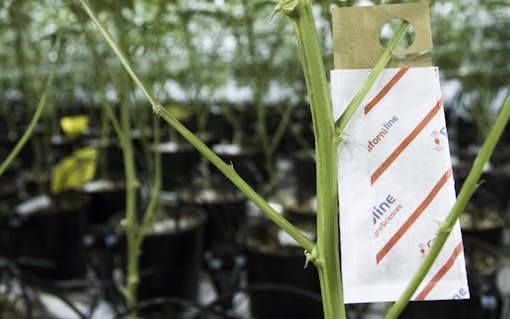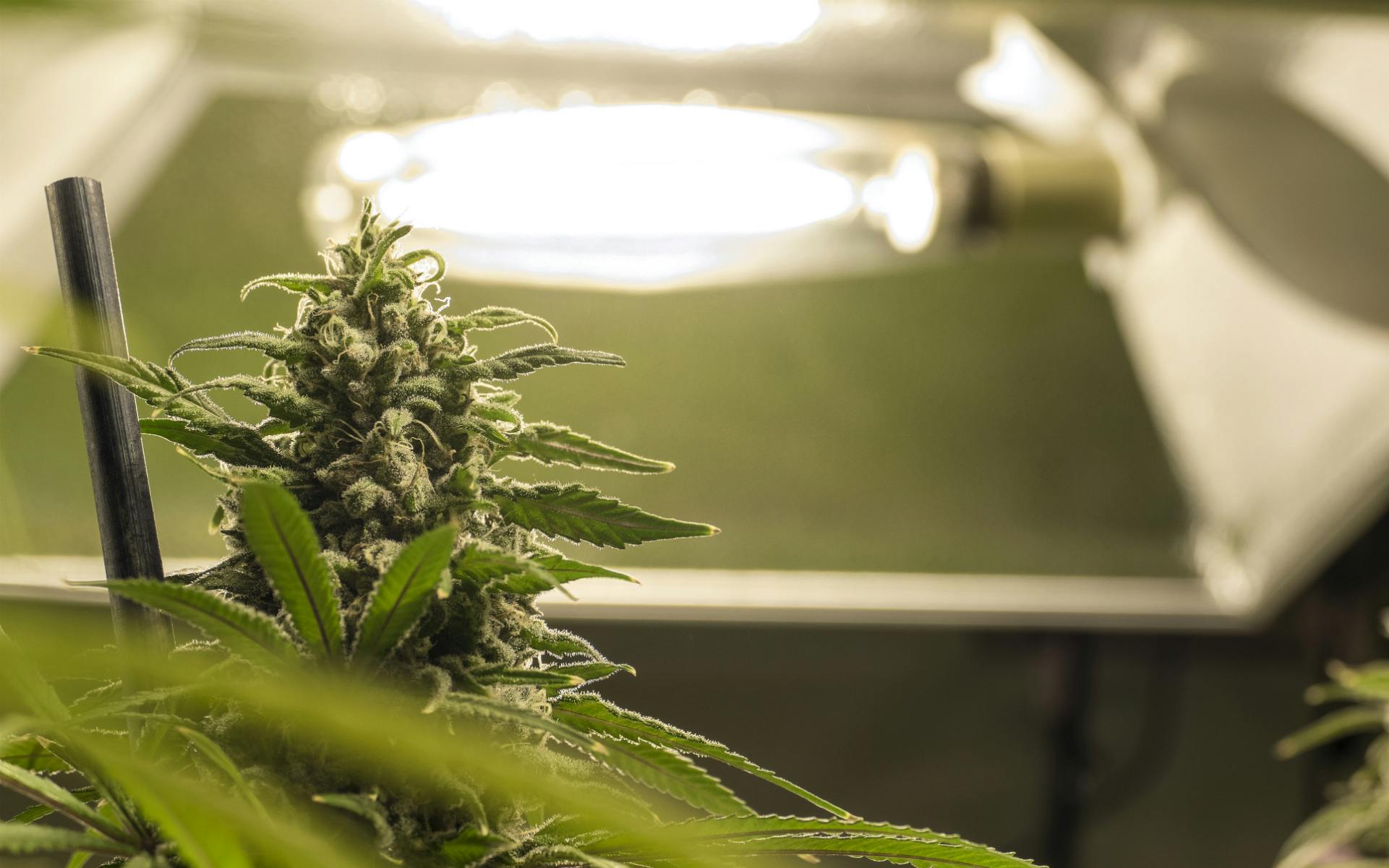Commercial cannabis farming for legal markets has seen increased control over what products and pesticides can be used to grow cannabis. Regulations are meant to protect consumers from dangerous pesticides that are widely used in the black market. Unfortunately, pesticides are still found in legal cannabis markets, calling for better testing and quality assurance regulations.
For now, consumers—especially those with compromised immune systems or sensitivities to pesticides—are encouraged to learn how growers approach pest control to ensure that a product is clean and safe.
Chemical-free pest management offers a solution to pests by using biological control agents. Biological control agents, also known as beneficial insects, are predatory mites and insects in various stages of development. By releasing beneficial insects into a garden space, you introduce natural predators to the common pests that damage your crop. Beneficial insects can be used as a preventative measure or for treating outbreaks, saving growers from having to resort to harmful or illegal pesticides.
Since 2014, the company Natural Enemies has worked with cannabis producers around the country to introduce beneficial insects as an alternative to pesticide use. Natural Enemies was founded by Shane Young, who worked for ten years as a plant health manager at Woodburn Nursery in Oregon. Leafly sat down with Briggs Lipsitz of Natural Enemies to learn more about beneficial insects, and then watched their products in action at Khush Kush—a cannabis farm in Bellingham, WA.
How Beneficial Insects Work

Khush Kush’s head gardener Cody Erickson had been using biological control agents for several months for preventative treatment. (Trevor Hennings for Leafly)
Beneficial insects are a foreign idea to many cannabis farmers, so let’s begin with some frequently asked questions about biological control agents.
How Do I Introduce Predatory Insects?
Biological control agents come in numerous forms and thus work differently from product to product. Natural Enemies sources their beneficial insects from British Columbia and California before being shipped overnight. Products containing beneficial insects are delivered either in sterilized vermiculite or bean larvae depending on their stage of development.
Once obtained, the beneficial insects are released in numerous ways including hanging sachets, direct application to soil, or by simply opening the packaging in the grow space. After release, the beneficial insects will traverse your garden space and detect food (i.e., your pests).
Can Beneficial Insects Be Used to Treat Active Pest Outbreaks?

A hanging sachet containing beneficial insects. (Trevor Hennings for Leafly)
Biological control agents work best as a preventative tool. The continual introduction of beneficial insects will keep predators at bay without allowing them to gain enough traction to cause a full-on outbreak.
These biological control agents can be used to treat active outbreaks, but the process can take a number of weeks before you start seeing results. It’s difficult to judge how long it will take for beneficial insects to reclaim your garden, depending on the size and severity of the pest outbreak. Traps can help keep growers informed on bug populations in the garden and alert growers of developing threats.
How Long Do Beneficial Insects Live?
The lifespan of beneficial insects varies from product to product, and also depends on whether or not you’re using the beneficial insects for prevention or outbreak treatment. Most products need to be reapplied every 2 to 3 weeks for outbreak treatment and sometimes slightly more frequently for preventative treatment, as the beneficial insects do not have a reliable food source.
For a longer lasting product, Bioline produces sachets containing beneficial mites with additional food, allowing you to continually release beneficial insects for 4 to 6 weeks.
Khush Kush: ‘This Is the Future of Cannabis Farming’

Khush Kush’s head gardener Cody Erickson had been using biological control agents for several months for preventative treatment. (Trevor Hennings for Leafly)
Khush Kush’s head gardener Cody Erickson had been using biological control agents for several months for preventative treatment, but became further intrigued after attending The Science of Regenerative Cannabis Cultivation Conference in Portland, Oregon.
“After talking with experts like Suzanne Wainwright, Scott Granola, Jeff Lowenfels, and many others, we got a good confirmation that we were on the right track with biological control agents,” Erickson said. “We may not be fully organic, but pesticide-free should be the goal of every farm anywhere.”
The idea of introducing any sort of insect to Khush Kush’s garden was intimidating, but after trying beneficial insects, the results spoke for themselves.
“I believe this is going to be the future of any sort of cannabis farming,” Erickson said. “Bio-controls have been around for a long time, but the cannabis industry is a few generations behind large-scale agriculture, and we should all be taking notes.”
During my visit to Khush Kush, Cody and his team received a number of Natural Enemies products including Dalotia coriaria, Stratiolaelaps, and Amblyseius andersoni in hanging sachets. Each product has its own unique predators and distribution methods.
Dalotia coriaria
Common prey: Fungus gnats, pupating thrips, and root aphids
Better known as a rove beetle, Dalotia coriaria are released in your garden by opening the container in multiple locations. Rove beetles fly and independently make their way around your garden looking for their food source. Dalotia coriaria feed primarily on fungus gnats, pupating thrips, and root aphids. Their lifespan tends to be around 21 days, and they are commonly paired with Stratiolaelaps.
Stratiolaelaps
Common prey: Fungus gnats, Western flower thrips, root aphids, mites
Stratiolaelaps make a great companion to Dalotia coriaria as they attack the larvae of fungus gnats, pupating thrips, and immature root aphids. They are applied by dispersing the vermiculite/Stratiolaelaps mixture in individual pots and go to work immediately. Their lifespan is 18 days, and can survive without direct food sources by consuming algae and plant debris.
Amblyseius andersoni
Common prey: Broad, cyclamen, russet, and spider mites
Used to combat an array of mites, the Amblyseius andersoni goes after broad, cyclamen, russet, and spider mites. Best dispersed with hanging sachets, Amblyseius andersoni will continually breed for 4 to 6 weeks from the sachets.
In an emerging industry where education is key, companies like Natural Enemies strive to make a positive impact. Keep an eye out for their free workshops, which take place across various markets.
“We feel the more well-armed growers are with knowledge, the more successful they will be with these products,” Lipsitz said. “It’s not just about repping our company. The more educated the grower base is, the more successful folks will be, and we feel that’s priority number one.”






